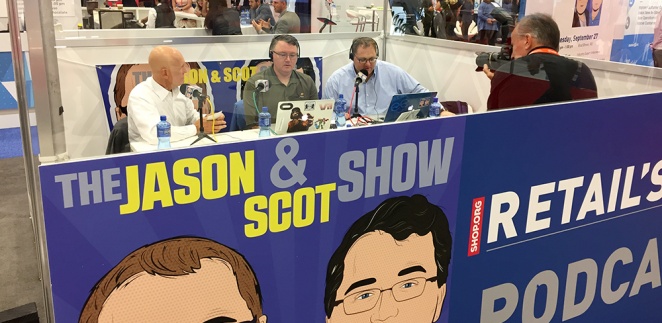At Retail’s Digital Summit, Razorfish Senior Vice President of Commerce and Content Jason “Retailgeek” Goldberg and Channel Advisor founder and Executive Chairman Scot Wingo debated four of the biggest challenges facing the retail industry. Each challenge can have different outcomes, and the hosts of ‘The Jason & Scot Show’ podcast presented different ways retailers can adapt, according to how they view the issues.
- 200 Amazon fulfillment centers worldwide to Walmart’s 10
- 44% of U.S. consumers live within 20 miles of an Amazon fulfillment center; 90% live within 15 miles of a Walmart store
- Amazon captured over half of all retail growth (not just e-commerce) in 2015 Q4; all of Walmart’s growth came from groceries
- Amazon’s net profit over 21 years is dwarfed by Walmart’s profit in just 2015
The Amazon effect
Amazon’s iron grip on retail sales makes it a tough competitor for most retailers. “Retailers don’t have weather problems,” Wingo says. “They have Amazon problems.” The market share of Amazon Prime and Marketplace along with recently unveiled Prime Air and drone delivery only adds to the retail giant’s unprecedented growth.
To successfully compete with Amazon, smaller contenders are innovating where it cannot. Best Buy has seen faster fulfillment times since it began shipping directly from its 1,200 stores, and other retailers like Macy’s, Target and The Home Depot use ship-from-store to take advantage of lower ground transportation costs. Nike and The North Face are facilitating product discovery with artificial intelligence to help online shoppers find and customize products.
Walmart, the only retailer bigger than Amazon, saw the most significant chunk of profit come through grocery sales in the last decade or so. Capturing grocery sales — the largest part of consumer discretionary spending — by introducing order online, pick up in-store capabilities has proven popular, as many customers still don’t want perishables delivered to their homes when they’re out.
Mobile gap
Conversion rates through mobile browsers remain three times lower than via desktop browsers, and shrinking down a website optimized for desktop onto a small mobile screen is not a solution. Consumers are browsing more on smartphones, generating over half of all web traffic, but when it comes to clicking the buy button, they still revert to a desktop browser.
It doesn’t help that the checkout process on mobile is still a nightmare on many websites; Go Go Wireless’s checkout screen had over 20 fields to fill out before it overhauled the process and reduced that number to four, quadrupling conversions. Mobile wallet options like PayPal and Apple Pay also promise a hassle-free checkout process. Progressive retailers have even started using technologies like chatbots to ease the friction of mobile checkout, talking customers through the process.
Retail apps can sometimes provide a better solution than optimized browser experiences. Amazon dominates smartphone home screens, with many users placing the app icon near the thumb area for faster access. Consumers are spending more time in apps than on mobile web, but so far, only large companies like Walmart, eBay and Google have succeeded in providing a seamless experience. Of the top 25 mobile apps, only two are retailers — Amazon is number 12 on the list. For inspiration, look to China’s Alibaba and WeChat, which have been successful in convincing consumers to transact via app.
Top physical retailers offer experiences that are hard to replicate online.
Brands selling direct to consumer
With the advent of online retail, brands are poised to sell directly to consumers without retail stores. On the supply chain spectrum, retailers range from bricks-and-mortar stores without e-commerce capabilties to fully digital stores with no physical locations. Wingo thinks that more brands are moving toward pure-play digital, but should all companies and consumers embrace this trend? Goldberg says that buying direct from brands is “still the worst choice in terms of price, choice and delivery reasons.” The top five physical retailers (by sales per square foot) in malls — Apple, Warby Parker, Tiffany & Co., Lululemon and Michael Kors — all have experiential factors that are hard to replicate online and attract a lot of customers to visit and buy in person.
The future
Looking to the future in this quickly evolving landscape, the only constant seems to be change. A promising trend is that technology adoption rates are accelerating: Microwave ovens took about 30 years to sell 100 million units, but augmented reality videogame Pokémon GO was downloaded 500 million times in its first six weeks.
Some trends to watch in the future:
- Distributed commerce – “Boundaryless retail” bundles all the touchpoints where purchasing decisions can be made, from Amazon Dash buttons to interactive window displays to social commerce.
- Cognitive computing – Smarter and faster computers can reduce much of the friction of the shopping experience with artificial intelligence platforms like Amazon Alexa, IBM’s Watson and Google Now.
- Augmented and Virtual Reality – AR/VR technology stands poised to radically change the shopping experience, whether it’s using an app to try new lipstick shades or wearing a headset through a virtual mall.
- Drones – Unmanned aerial vehicles will be used to deliver orders faster: Google ran an experiment to deliver Chipotle burritos via drone, and Amazon has filed for a patent on flying warehouses that could make drone deliveries work at scale.

Goldberg and Wingo will record two episodes of their podcast ‘The Jason & Scot Show’ at Retail’s BIG Show in January. Fellow podcasts Beauty Skew featuring Abigail Posner, Digiday’s The Glossy Podcast, NASDAQ’s Behind the Bell, and Total Retail will also visit the podcast studio at Retail’s BIG Show.
Until then, check out these episodes recorded at Shop.org.